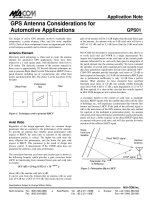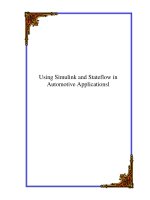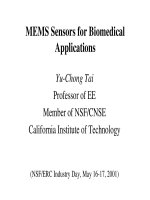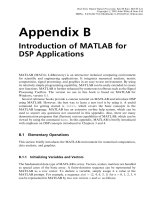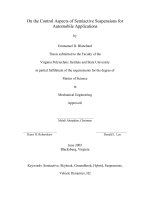Gps Antenna Considerations For Automotive Applications
Bạn đang xem bản rút gọn của tài liệu. Xem và tải ngay bản đầy đủ của tài liệu tại đây (51.99 KB, 4 trang )
Specifications Subject to Change Without Notice
M/A-COM Inc.
North America: Tel. (800) 366-2266
i Asia/Pacific: Tel. +85 2 2111 8088 i Europe: Tel. +44 (1344) 869-595
Fax (800) 618-8883 Fax +85 2 2111 8087 Fax +44 (1344) 300-020
Application Note
GPS Antenna Considerations for
Automotive Applications
GPS01
The design of active GPS antennas involves essentially three
components: a patch element, filter, and low noise amplifier
(LNA). Each of these components forms an important part of the
overall antenna assembly and is critical to performance.
Antenna Element
Microstrip patch technology is often used to create the antenna
element for automotive GPS applications. Sizes have been
reduced to a 1 inch square puck, with thicknesses from 0.16 to
0.25 inches. The dielectric constant of the ceramic material in
these cases is approximately 20. Several different techniques are
used to generate Right Hand Circular Polarization (RHCP) from a
patch element, including use of a polarization slot, offset feed
points, and polarization tabs. The choice is at the discretion of the
designer.
Figure 1: Techniques used to generate RHCP
Axial Ratio
Regardless of the design approach, there are common design
parameters that are essential to the performance of the antenna.
To provide an antenna that exhibits good performance with
respect to RHCP, the axial ratio (a measure of the antenna’s
polarization purity), is critical. The higher the axial ratio, the
more elliptical the polarization, and the lower the gain with
respect to RHCP. This parameter is the result of design and
process control. A measurement of the VSWR alone does not
guarantee the antenna’s axial ratio performance.
The correlation between axial ratio and circular gain is shown in
the following formula, which provides a gain correction factor
(GCF) in transitioning from measured linear gain and axial ratio
to circular:
GCF (dB) = 20 log [(1/Ö2) (1 + 10
-(AR/20)
)]
where AR is the antenna axial ratio in dB.
It can be seen from this formula that an antenna with an axial
ratio of 0 dB has a GCF of +3.0 dB. This means that the circular
gain of the antenna will be 3.0 dB higher than the peak linear gain
of the antenna. An antenna with an 8 dB axial ratio will have a
GCF of -0.1 dB, and be 3.1 dB lower than the 0 dB axial ratio
antenna.
M/A-COM has developed a measurement process that allows us
to verify axial ratio and VSWR in a single measurement. We
impose strict requirements on the axial ratio of the ceramic patch
antennas fabricated for us, and verify them prior to integration of
the patch element into the antenna assembly. We have evaluated
the antennas of several other manufacturers and repeatedly found
that these parameters significantly deviate from optimized. M/A-
COM GPS antennas provide boresight axial ratios of 2.0 dB or
better typical on boresight. At 2.0 dB, the deviation in RHCP gain
due to polarization inefficiency is only 1.0 dB from a perfect
antenna. Other antennas we have measured have specified
boresight axial ratios of 4.0 dB, but actually exhibit boresight
axial ratios from 6 dB to 13 dB, a gain degradation of 2.5 to 4.5
dB from optimal. It is clear in this case that the controls imposed
in M/A-COM designs are not in place elsewhere.
A secondary benefit to the control of axial ratio is multipath
rejection. RHCP signals from the satellite that reflect off the sides
of buildings, etc., will experience a polarization flip with the first
bounce and become LHCP. If the path of the reflected signal is
still in the main beam of the GPS antenna, then the only method
for rejection of the multipath is polarization purity. An antenna
with good axial ratio performance and therefore good polarization
purity will have a better response to the direct RHCP signal than
an antenna with poor axial ratio, and will also provide for better
rejection of the reflected LHCP signal.
Offset Feed
Polarization
Slot
Tabs
Receive
Antenna
Direct RHCP signal
LHCP signal
Polarization Flip
at Reflection
Figure 2: Polarization flip to LHCP
Wave
front from
Satellite
GPS Antenna Considerations for Automotive Applications GPS01
Specifications Subject to Change Without Notice.
M/A-COM Inc.
North America: Tel. (800) 366-2266
i
Asia/Pacific: Tel. +85 2 2111 8088
i
Europe: Tel. +44 (1344) 869-595
Fax (800) 618-8883 Fax +85 2 2111 8087 Fax +44 (1344) 300-020
0.00
1.00
2.00
3.00
4.00
5.00
0123456
Resonant Frequency
Equally important in the fabrication of GPS antenna elements is
the control of resonant frequency. M/A-COM has a thorough
understanding of the effects of radomes on the antenna resonant
frequency. The packages we use for GPS antennas were
considered in the specification of the resonant frequency
performance of the patch antenna itself. As such, the VSWR and
axial ratio requirements discussed earlier are set at a specific
frequency range. This range is set higher than the final operating
frequency band of 1575 MHz ± 3 MHz to assure the final
assembly obtains optimized operation over the correct frequency
band. These characteristics are verified on each antenna element
and the final operating parameters are verified on the finished
assembly.
A thorough understanding of the effects of the dielectric loading
of radomes is essential to consistently produce hardware.
Measuring frequency vs. axial ratio, we have seen shifts in
resonant frequency from 1535 MHz to 1595 MHz in antennas
produced elsewhere.
Figure 3: Randome effect on resonant frequency
M/A-COM carries this understanding of dielectric loading into
the unpackaged active and passive GPS antennas. We often test
antennas in our customers radomes and determine for them the
required distance between the antenna face and inner radome to
ensure optimized performance.
Ground Plane Size
The resonant frequency performance of each patch antenna will
vary based on the ground plane size. The designer must minimize
the effect of ground plane size on the antenna by achieving the
smallest size point where further changes will have negligible
effect on antenna performance.
Figure 4: Antenna Zenith Gain vs. Ground Plane Size
M/A-COM has set the resonant frequency and bandwidth of the
patch design to accomplish this task. Changes to performance
from no ground plane to 3 inches in diameter have a known and
balanced effect on the performance of our patch designs. This
change reaches a constant at approximately 6 inches in diameter.
Increases in the ground plane size beyond that have negligible
effect on antenna performance. Without this design control,
significant differences in radiation pattern performance will
occur.
Bandwidth
Bandwidth is a key parameter to the antenna. It is important to
provide as wide a bandwidth (both VSWR and CP purity) as
possible to increase production yields and lower costs. It is also
important to provide a relatively narrow bandwidth to optimize
out-of-band rejection due to the antenna element alone. This helps
in the rejection of signals that could be imposed on the LNA, and
reduces the requirements on the bandpass filter to achieve overall
antenna rejection.
The design of the patch antenna utilized by M/A-COM optimizes
CP bandwidth over the VSWR band. The range of frequencies
over which the antenna exhibits acceptable CP performance is
only somewhat less than the VSWR bandwidth, and the rejection
characteristics outside the bandwidth are maintained. The choice
of a thin (0.160 inch) dielectric aids in accomplishing an antenna
design that extends CP bandwidth performance.
Voltage Standing Wave Ratio
While the VSWR measurement of the patch element itself will
not stand as satisfactory, it cannot be ignored. Poor VSWR results
in poor gain due to signal lost to mismatch reflection. The
antenna elements designed by M/A-COM have in-band VSWR of
1.5:1 or better. This translates to a mismatch loss of only 0.28 dB.
The formula for relating mismatch loss to VSWR is:
Mismatch Loss (dB) =
10 log [1 - {(VSWR -1)/(VSWR +1)}
2
]
VSWR
1.5:1
Resonant frequency
shift caused by radome
Frequency:
1575.42 MHz
GPS patch
installed in
radome
GPS patch in
free space
Ground Plane Size (in inches)
GPS Antenna Considerations for Automotive Applications GPS01
Specifications Subject to Change Without Notice
M/A-COM Inc.
North America: Tel. (800) 366-2266
i
Asia/Pacific: Tel. +85 2 2111 8088
i
Europe: Tel. +44 (1344) 869-595
Fax (800) 618-8883 Fax +85 2 2111 8087 Fax +44 (1344) 300-020
LNA
The LNAs used in M/A-COM’s active antennas are high
performance GaAs MMICs in low cost SOIC 8-lead surface
mount plastic packages. These LNAs employ monolithic 3 stage
self-bias designs and a simple external matching network (PC
board), to obtain a minimum noise figure. The LNA is ideally
suited for use where low noise figure, high gain, high dynamic
range, and low power consumption are required. The LNA is
fabricated using a mature 0.5-micron gate length GaAs process
which features full passivation for increased performance.
These parts are individually tested for gain and noise figure
before being supplied to M/A-COM. The excellent NF of these
devices allows us to provide an antenna assembly with an
outstanding and reliable noise figure. The LNAs are PC board
matched to the operating band of 1575 MHz. The consistent
center frequency of the antenna element, coupled with an LNA
that is also optimized to 1575 MHz, results in a very efficient
device.
The use of M/A-COM MMIC amplifiers significantly reduces the
parts count normally associated with a discrete FET device. The
result is a measurable increase in the MTBF of the antenna
assembly.
M/A-COM LNAs also provide excellent RF performance over a
range of DC biasing. They are capable of specified operation at a
bias voltage as low as +3 VDC. Even at this low voltage, current
draw is not increased.
Filter
The bandpass filter used in an active GPS antenna is an important
component. Out-of-band rejection can be a critical factor in
determining whether the GPS system will continue to operate in
the presence of interfering signals such as a cellular car phone.
M/A-COM provides two levels of filtering in its active GPS
products. Both are ceramic bandpass devices, one a two-pole and
the other a three-pole. In each case, the individual filters are
tested to the requirements of center frequency, insertion loss, and
rejection at ± 50 MHz (or other), before being integrated into the
assembly. This, like the LNA, assures that all three individual
components are optimized at the desired frequency of 1575 MHz,
providing an efficient antenna assembly.
The positioning of these three elements is important to the overall
noise figure (NF) of the assembly. By placing the LNA directly
after the antenna element, and before the filter (in a receive
direction), the NF of the antenna assembly will be essentially that
of the LNA. In this case, it is important that the rejection of the
patch element be maintained to reduce the level of out-of-band
signals on the LNA.
PCB Design
A poor PCB layout can destroy what may otherwise be a good
design. The PCB must be laid out to assure that no RF coupling
between the line exists to compromise performance. DC bias lines
must have adequate RF chokes at all key locations. RF lines must
have good DC blocks to assure that each LNA is biased properly.
The PCB must provide the required matching input and output to
the LNA(s).
M/A-COM has thoroughly evaluated each PCB used for our
active GPS antennas. RF chokes and DC blocks are located as
required to maintain RF performance. Additionally, M/A-COM’s
active antennas are the only ones that use an RF shield to assure
performance. A metal shield encases the component side of the
printed circuit board, eliminating RF coupling and re-radiation
from the patch element.
Testing
M/A-COM maintains rigid testing requirements to ensure that all
components are performing to specifications. The patch element,
low noise amplifiers, and filter are individually tested against
specific RF requirements, either by M/A-COM or by our supplier.
The final antenna assembly is then tested for RF performance.
Typical final testing consists of VSWR, swept gain, and out-of-
band rejection.
Summary
Overall gain alone is not the true indicator that a GPS antenna is
suitable for an automotive environment. The quality of the
product starts with the performance of the patch element. Proper
design assures consistency of the axial ratio performance, both at
the specified level and the actual variance from part to part. If this
parameter shows poor performance, it is safe to assume that the
resonant frequency is not well controlled; the overall design is not
optimized for efficiency and out-of-band rejection.
Swept gain data can be an indicator of a less than optimized
design. The LNA and filter will each have their own pass bands
Thin PC Board
Plated through
VIAS
Patch
Antenna
Shield Can
(components contained
within)
RF
Cable
Shield can be
grounded to PCB
Figure 5: RF Shielding for Active GPS Antennas
GPS Antenna Considerations for Automotive Applications GPS01
Specifications Subject to Change Without Notice.
M/A-COM Inc.
North America: Tel. (800) 366-2266
i
Asia/Pacific: Tel. +85 2 2111 8088
i
Europe: Tel. +44 (1344) 869-595
Fax (800) 618-8883 Fax +85 2 2111 8087 Fax +44 (1344) 300-020
(which should be centered on 1575 MHz). If the antenna element
is not centered here, then the gain data will have an asymmetrical
response around 1575 MHz. Rejection out-of-band will not be
optimized.
M/A-COM has paid very close attention to all the details that
make an active GPS design an excellent one, and we have
incorporated them into our design.
Test Type Method
Thermal Shock -40°C to +85°C ; 10 cycles; 1
hour each hour
Moisture Susceptibility -20°C soak; 45°C 95%
relative humidity; 4 hours
Random Vibration 3 axes of 10 Hz/.04 GG/Hz to
1000 Hz/.002 GG/Hz
Salt Fog Unit sprayed with salt
solution; temperature soak at
49°C and 60°C for 16 hours
Mechanical Shock 3 axes; 20 G’s peak 6 times
per axis
Drop Test 1 meter height onto hard
concrete surface; 6 times
Power Temperature Cycling 1000 hours of temperature
with 5V bias cycle
Low Temperature Endurance -40°C with cycled 5 V bias
Biased Humidity call for test procedure
Electrostatic Discharge call for test procedure
Immunity to Radiated
Electromagnetic Fields
call for test procedure
Figure 6: Environmental Tests for GPS Patch Antennas

